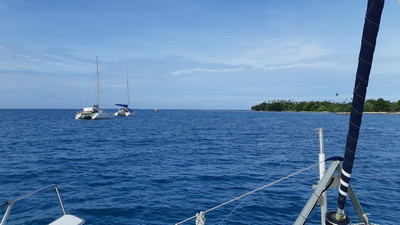
Once we got anchored, our first visitors were Oscar and Stanley.
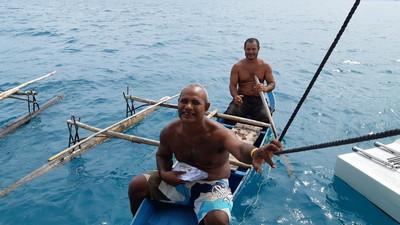
We had already been told of these two from other friends who had visited in prior years. Oscar who seems to be the patriarch of Longan, and Stanley, his nephew, both speak good English. They understand cruisers and wanted to both welcome us to their island, but also ensure that we could rest up today, and be officially welcomed tomorrow. They also wanted us to understand that when their people came by with gifts of fruit and veggies, that we consider them gifts, and that we were not required to trade for them.
We told Oscar of the piles of donated items and trade goods that we had brought for them, plus some specific items other cruisers had sent us for specific people on the atoll. Oscar said "That's very nice of you, but first we want to welcome you to our island in our custom." He invited us all in for a welcoming ceremony the next day.
The day we arrived, we had a number of visitors in wooden dugout canoes, bringing us gifts of bananas, sweet potatoes, coconuts and "cabbage" (local greens, not cabbage).
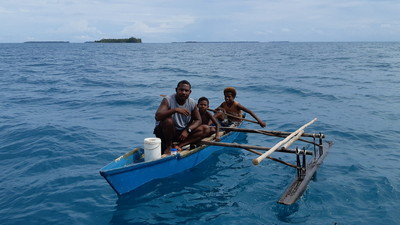
In return they asked for T-shirts, cigarettes, rice and sugar, and movies on their cell phones. There is no cell network out this far, but some of the younger crowd had acquired cell phones that they used mostly for movies and music. It was hard to get much done that first day, with a fairly constant stream of visitor. Fortunately, once they felt they had properly welcomed us, the visitors dropped off almost completely, unless specifically invited.
The next day, we (as we had been asked to do), all arrived on the beach at the same time, while the villagers gathered to welcome us. They sang a beautiful song of welcome, and then they fed us. And at first, only we sat at the table, and only we ate. It was weird, but once we cruisers all had a generous plateful, the rest of the two families who were hosting us (Oscar and Stanley), all dug in to what was left over.
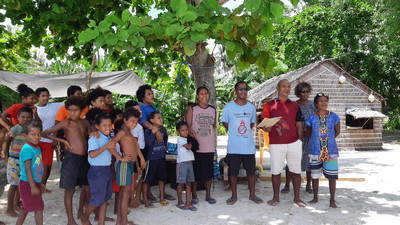
The song they sang us was a variation of a gospel song called Sailing Toward Home:
I stood upon the sandy beach
Looking out across the ocean
I saw your ships come sailing in
To rest beside the shore
The friends of those aboard
Were gathered there to meet them
It made me think of Heaven
Where friends will part no more
Chorus
You're sailing toward home
On the old ship of Zion
You see the lights upon the banks
Across the misty sea
Angels guard your vessels
'Til you're safe within the harbor
Captains guide your ships 'til you get home
Mama sailed the ship of life
And all the storms and weather
She told me of the Savior that would chart your destiny
The misty veil has lifted
You can plainly see the harbor
And Mama standing on the bank
She smiles and welcomes you
After lunch, one of the teen age girls (plus a few trailing kids) took us on a tour of the southern part of the island, including the school.
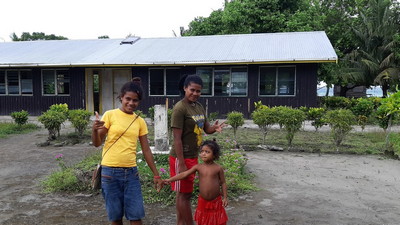
This was an incredibly clean and neat village, with every path swept nicely and lined with flowering shrubs. All of the houses were constructed of wood frames with woven pandanus leaf walls and a thatch roof.
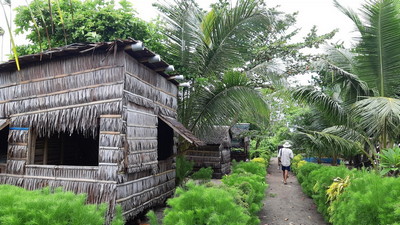
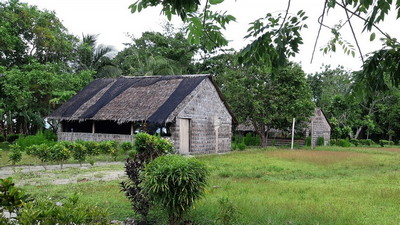
In all, the school has 4 rooms and covers 4 grades. The school for the other 4 grades is on Amik Island, across the lagoon. The kids who go to a school that is not on their island board during the week with a relative on that island. (and everyone is a relative of everyone else in the Ninigos).
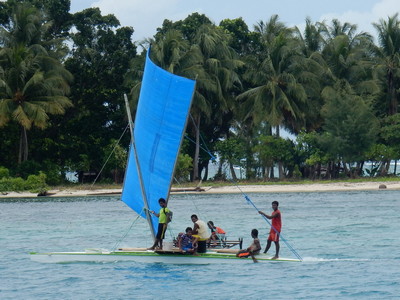
During our stay at Longann we visited several houses that were under construction. The houses are traditionally built on ground level, but we were told that any future construction would be built up on posts, about 4-6ft off the ground. (anticipating sea level rise)
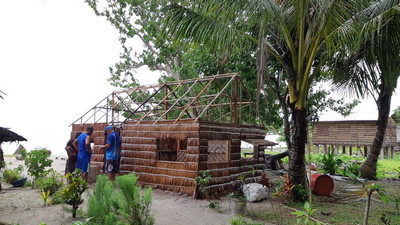
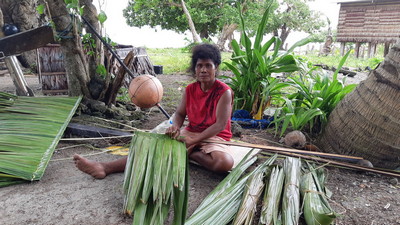
On another day, Stanley also took us on a birdwatching/garden tour.
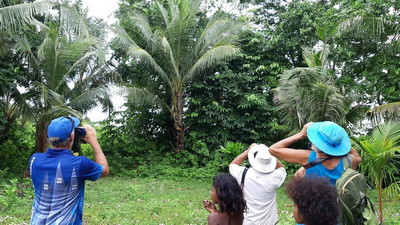
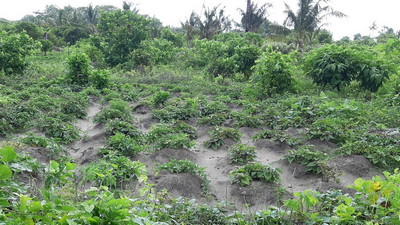
One of the staples on the island is Cassava. We had seen Cassava plants before, and seen Cassava roots sold in the markets, but had never had the process required to make Cassava into an edible food explained to us. Stanley showed us the process.
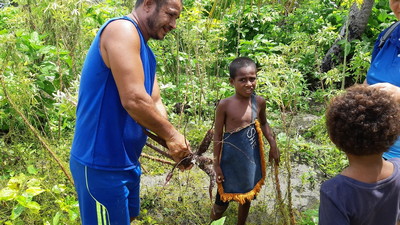
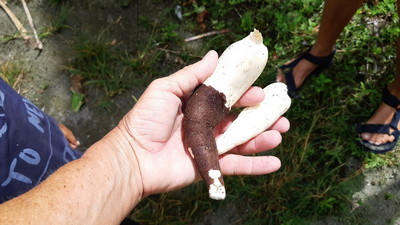
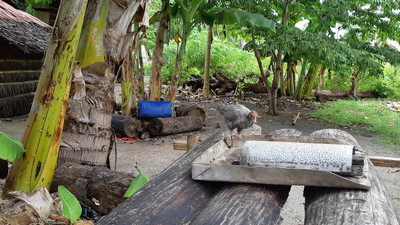
Cassava is fairly poisonous in it's raw state. There is a high level of cyanide in some strains of cassava. So the grated root must be soaked in water and then boiled.
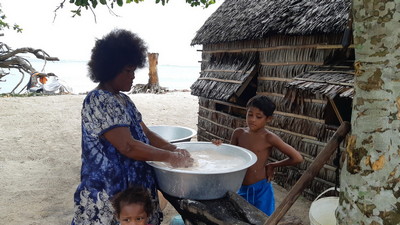
After boiling, the mixture is strained and dried, and when fully dry, becomes Cassava Flour. Cassava Flour is then used to make Cassava Cakes and other local staple foods.
Another local staple is coconuts. Young Coconuts provide drinking water, the meat from older coconuts is scraped and processed to produce coconut oil and sweet coconut milk, which is used in making most of their foods.
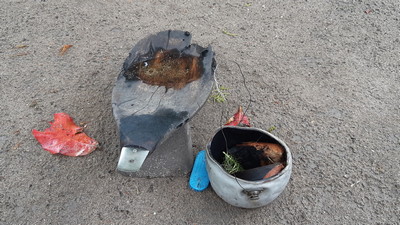
In subsequent days, about every other day, someone on the island invited all 8 of us in for dinner. It was not a potluck invitation--we weren't supposed to bring anything. It seemed to be a genuine desire to get to know us, and be hospitable. We all felt like we were eating them out of house and home! Though every meal featured some seafood from the lagoon, every meal also included a chicken and some rice, both precious commodities in this village 300 miles from the nearest store. They also included Cassava Cakes and coconut sweets. We brought gifts and food items to share that we knew they would not get on the island--a big pan of brownies, some fresh-baked bread, etc.
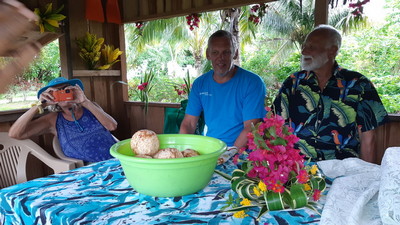
These dinners were just a part of Pacific Island hospitality. But also a way for the islanders to learn about the outside world. They are intensely curious about who we are and what we're doing there.
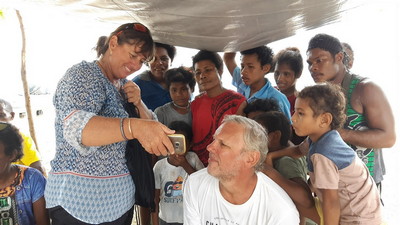
Our friends on Carina, who had last been to the Ninigos for 5 weeks in 2016, had written a "Cruiser's Guide to the Ninigos", providing helpful information about the entire atoll--the 4-5 communities scattered around on various islands and who the "players" were on each island. We had hoped to get around and visit all the communities, but the weather didn't cooperate, and we are on a bit of schedule and feel like we need to keep moving east while the wind is favorable. So we had a decision to make--hit every community for a day or so visit , or stay at Longan the whole time and really get to know Longan. We decided on the latter.
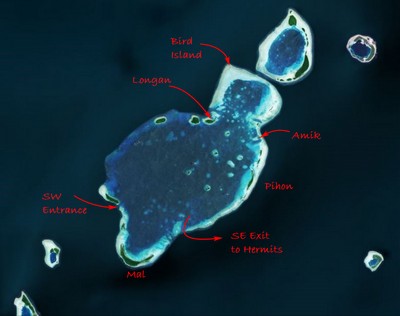
Longan is not the most populated island in the atoll, and in some seasons is on the downwind side of the atoll, and therefore not as often visited by prior cruisers. But in the NW season (now), it is the most protected from the winds we were experiencing. However, a bit of the outside wave action rolls in around the southern tip of Longan from the west-facing opening. With winds constantly varying between nearly north and nearly west, and between 5 knots and 25 knots, we often had quite a bit of wave action in the anchorage, which we hadn't expected at all. We had nearly a week of fairly squally weather while we were there--not the idyllic light wind weather I had pictured, and which we had left behind in Indonesia.
The main atoll is 18 miles long and 9 miles wide, a circle of islands with a deep lagoon inside. And there are a few surrounding smaller atolls nearby, with about 10-12 miles of the primary atoll. Most of the larger islands on the rim of Ninigo are inhabited by a related set of families, though there is a lot of sharing, trading, and intermarrying going on between the families on the various islands. Mal is the most populated island and is where there is a small clinic, and another primary school. If the kids want to go to high school, they must go to the school in the Hermit Islands (50 miles away across open ocean).
After our first couple of days getting to know the Longan People, we arranged with Oscar to bring all our donated goods ashore for a good old fashioned "yard sale". Not only did we have the usual donated good--clothing, school supplies, etc, but we also had a package of 350 copper nails donated by our friends on Carina. Copper nails are especially valuable for canoe-making, as they don't rust, and they are soft enough to be pulled out and re-used. We had also bought 2 Garmin Etrex hand-held GPS's, plus donated a couple of older handheld GPS's we didn't need any more.
Though we had intended to GIVE the stuff to Oscar to distribute, Oscar felt that this wouldn't benefit his people in the long run. He wanted us to sell the donated items (for a very low price), and then use the proceeds for the community good. He felt that, because people had to pay hard earned money for items they wanted, they would appreciate them more. So we brought everything ashore to Oscar's house, and Oscar and his wife Keren, and Eileen, one of the schoolteachers, helped us price everything.
Then we laid everything out on tables, and Eileen was designated to take the money.
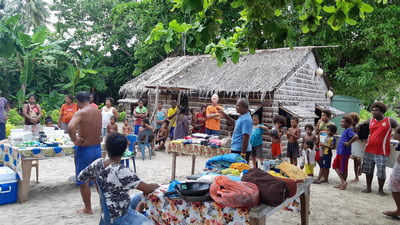
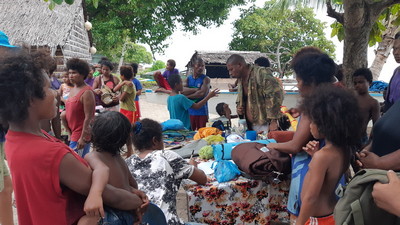
Shoes, hats, sunglasses, reading glasses, cookware, shorts, and t-shirts, all were rummaged over by the islanders.
After the Yard Sale, the villagers held a meeting in the schoolhouse, and Eileen gave a report.
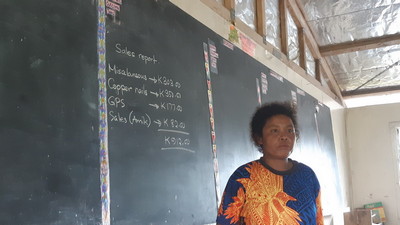
Oscar and Eileen split the money 50/50--half going to the village expense pool, and half going to the school. The village expense pool goes to things like fuel for the outboard motors for provisioning trips to Manus Island, several hundred miles away.
One of the most amazing things about Ninigo is that the people are still using traditional sailing canoes for their local transportation around the atoll. We managed to arrange a trip up to a "Bird Island" in the NW corner of the atoll, on the traditional sailing canoes.
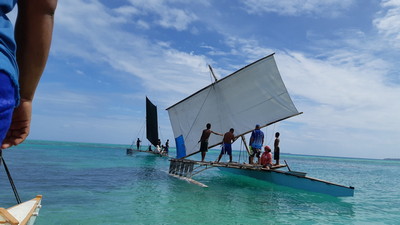
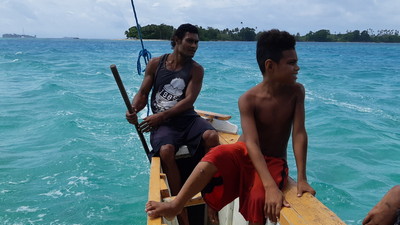
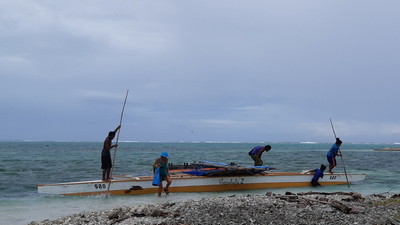
It was really wild skimming along inside the reef, on the sand banks, over the tops of coral heads. It was a squally day and we got into a little squall on our way up--I had my phone out with OpenCPN on it, and my GPS said we were doing 13 knots!
There were a lot of common sea birds on the island--one of the young girls climbed around in trees gathering eggs from the bird nests. There were also a number of pigs on the island--it's easier to let them roam on the island with no people and no gardens than have them running around on the home island. There were a couple of cute little piglets--two of whom came back with us in the canoe.
The kids on these islands grow up on the water, so they are permitted out in canoes on their at a very young age.
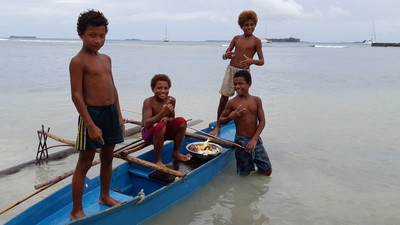
On Sundays, the people of Longan and the people of Amik, the island just opposite Longan, get together for sailing canoe races. On this Sunday, they were to be held at Amik. Indigo II, one of our cats, offered to take Oscar and Stanley, and a couple of us across to Amik. The rest of us were going to sail across in canoes.
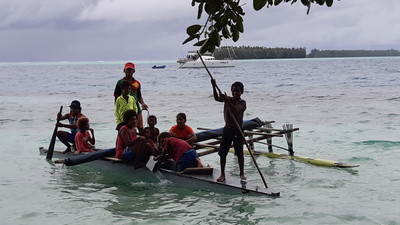
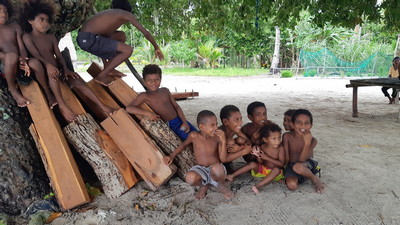
It was a rainy day, and it started pouring just after we arrived at Amik. No problem, everyone just holed up under someone's roof until the rain stopped.
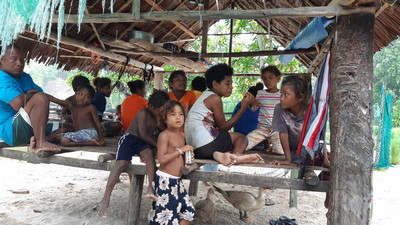
We had all packed a lunch and left it on Indigo, thinking we'd be able to hang out on Indigo and watch the races. Well, it didn't work that way. For whatever reason, they directed Indigo to anchor at the east end of the village, and the canoes ended up doing their start from the west end of the village. Poor Liz and Chris felt that the anchor spot was a poor one, with a rubble bottom they didn't trust, and they were backed up to the reef. So they didn't want to leave their boat--they ended up staying aboard the whole day.
Once the local villagers heard about Indigo going across, several people asked for rides for themselves or their kids across to Amik. Apparently, on the following Monday, school was going to resume. The elementary school for Amik and Longan is split across the two islands. Amik houses the school for the lower elementary grades, and Longan the school for the upper elementary grades. So on the weekend prior to school resuming, there was a flurry of travel back and forth getting the kids and teachers to the appropriate islands. The kids who are not going to school on their home island board with someone--a relative, usually, on their school island. On the way from Longan to Amik, Indigo ended up with about 10 locals riding along, and on the return trip, about 14, and a bed mattress!
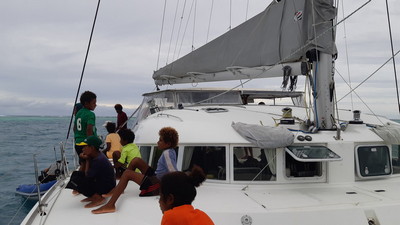
The races were a hoot. They start standing in the water, and must put up their mast and their lateen-rigged sail before jumping aboard and taking off. So part of the crew work is getting the sail up and rigged quickly. These boats don't beat at all, so they do long, fast reaches out into the lagoon. Then when they want to tack, they have to take the sail down and turn it around and put it back up on the other end of the boat. They only have one outrigger, which is always to windward. (I am working on getting a video uploaded to our YouTube channel).
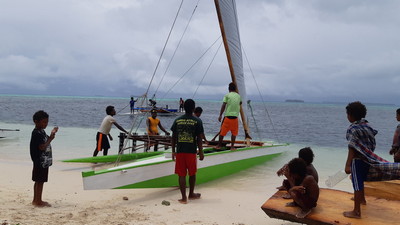
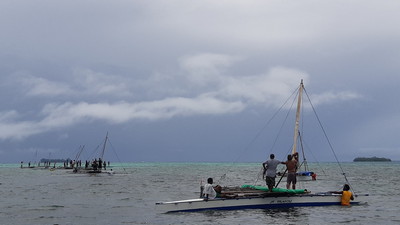
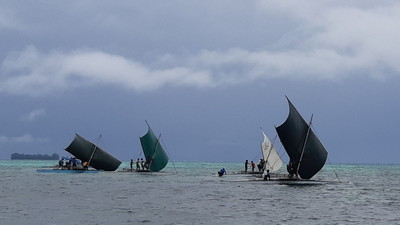
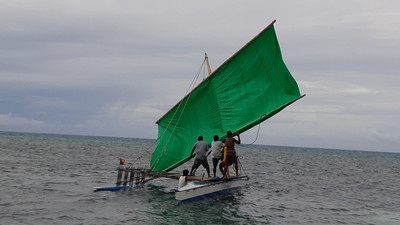
They were in the process of building a new 9 meter canoe where we were watching the race. As there are no large trees in the lagoon, they capture huge logs drifting from Indonesia, and use them for their canoes (and other construction). The bottom part of the canoes are hewed out of the logs, with additional boards used to build up the sides to give the canoe more freeboard. There is no working sawmill in the lagoon. Most of the woodwork is done by chainsaw.
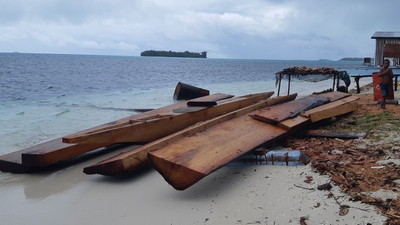
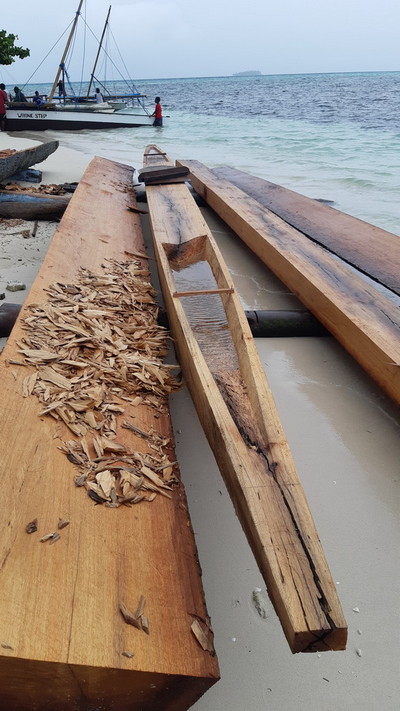
The islands were originally a copra plantation (making coconut oil), but when other sources of oil became cheaper to produce, the copra business died out. Now their main cash crop is "beche de mer" or sea cucumbers. For some reason, the Chinese think these are delicacies (medicinal?), and they will pay top dollar for properly preserved sea cucumbers. In other countries, the lack of control by the government have led to wholesale destruction of the reef ecology. Fortunately, in PNG, the government is trying to control the harvesting of sea cucumbers. There is a distinct season, and who can buy and sell is tightly regulated. But a couple of months of gathering sea cucumbers, and the Ninigo Islanders have enough cash to buy the things they need.
When they heard we were coming back to the Ninigos later this year, individuals would sidle up to us and ask us to buy things for them. They wanted to know what it would cost, and when we would be back, so they could save their beche de mer money to purchase the items from us. First and foremost on the list were Garmin handheld GPS's, and not the cheap Etrex 10's we had brought with us this time, but mapping GPS's that run $300-$400 US dollars. We ended up with "orders" for several GPS's, hand-held compasses, binoculars, solar controllers and batteries, and even a laptop. We'll do our best!
We didn't have the best weather when we were there--it was squally nearly every day. So we didn't do any snorkeling or diving, nor get a chance to explore as much as we would have liked. Next time!
On our last full day, the village held a good-bye dinner for us at the school. We took in what school supplies we had and donated them to the head teacher. We had a great time at Longan, and really hated to leave, but we have a lot of miles to cover if we're going to get all the way to Vanuatu before the SE trade winds set in in late May.
-----
At 2/4/2019 00:00 AM (utc) our position was 01°13.32'S 144°17.96'E
Great to hear about your voyage.Beautifully written and good photos.Thank you.
ReplyDelete